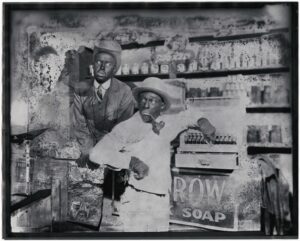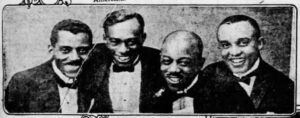Digital Learning Project: Understanding Shuffle Along and Its Times
So far, I have assembled 10 sample images (photographs, sheet music, and newspaper advertisements) that I’d like students to explore, four recordings made at the time of the show’s creation to evaluate, and two films, one by Sissle and Blake shot shortly after the show premiered and one by Al Jolson from about the same period, to compare. This material was all drawn from research I conducted previously in several different archives and collections to write my book. I selected these particular items because I think they are the most interesting for historical examination and discussion.
Questions
Some of my questions for developing my project are:
- How much “back story” do I need to provide for students to understand the material being presented?
- Should I include sample analysis for one or more of the exercises to guide possible student interpretation?
- Will students be sophisticated enough to be able to overlook the poor audio and video quality of the source material (all created in the early ‘20s)?
- How many lessons can I realistically create in the time given to create the project?
Next Steps
- Explore software that allows for student interaction with images, audio, and video materials.
- Create a sample lesson experimenting with different approaches to challenging student analysis
Images for Comparison


I selected two images of the show’s comedic stars, Flournoy Miller and Aubrey Lyles. The first image shows the duo as they appeared on stage in Shuffle Along. Although all of the actors and dancers were Black, only those playing comedic parts wore blackface. Blackface was a traditional trope carried forward from minstrelsy. In interviews at the time, the comedians did not express discomfort with appearing in blackface; in fact, they acknowledged that they used this makeup to enhance their comedic routines and to appeal to a large (white and Black) audience.
The second image includes all four of the show’s creators—Miller, Lyles, composer Eubie Blake, and lyricist Noble Sissle—as they were photographed at the time of the show’s premiere. In this image, all four sport tuxedos and are projecting an image of professional performers, just like the white composers, lyricists, and actors of the day.
The reason I selected these images is that they offer a stark contrast for students to explore between how Blacks presented themselves (and were presented) on stage; what the actual performers felt about the use of blackface and stereotypical clothing; and how these images were used to promote the show both in the African American and white press of the day. It is interesting to note that Miller was fairer skinner than Lyles but both used blackface to “darken” their complexions on stage–although Lyles was dark enough to not need to sport the blackface makeup.
Another item to explore is color prejudice among Blacks themselves. The chorines (dancing girls) in the show were expected to be fair-skinned; Josephine Baker was initially rejected for being “too dark.” This prejudice existed among both Black and white theatergoers and the show’s producers themselves.
Student Activities/Interactions
I intend to pose a series of questions for students first based on analyzing the overall image and then by focusing on specific aspects of the two images to compare and contrast. I will ask them to view the images alone and as they were reproduced in contemporary newspapers; read contemporary interviews and reviews; and interpret how blackface was both exploitative of and exploited by Black comics.
Another Possibility
Having now seen some of last year’s student projects, I’m thinking that I might be able to work with my podcast, WHAT HAPPENED TO LOTTIE GEE? that I created last semester as the basic “text” for analysis http://www.eubieblake.net/exhibits/show/what-happened-to-lottie-gee-. This is a 30-minute podcast that probes questions about why Lottie Gee–the lead actress and star of Shuffle Along–failed to establish herself in the (white) theater world after her initial stunning success. I think for students the podcast would have to be broken down into bite-size pieces that focus on different issues in Gee’s life–which could then be augmented by the actual source materials (newspaper articles, advertisements, audio recordings) that were used to tell her story. Students would be asked to analyze historic artifacts such as an advertisement for a hair-straightening tonic that Gee endorsed.
Given the time constraints and the need to focus on just a handful of key points, this might be the best way to go.